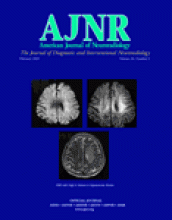Abstract
BACKGROUND AND PURPOSE: On diffusion-weighted (DW) images, primary hematomas are initially mainly hyperintense, and then hypointense during the first few days after stroke onset. As in other brain disorders, variations in the T2 relaxation time of the hematoma influence the DW imaging signal intensity. Our aim was to evaluate the contribution of the T2 signal intensity and apparent diffusion coefficient (ADC) changes to signal intensity displayed by DW imaging through the course of hematoma.
METHODS: The MR images of 33 patients with primary intracranial hemorrhage were retrospectively reviewed. Variations in T2-weighted echo planar images, DW imaging signal intensity, and apparent diffusion coefficient (ADC) ratios (core of hematoma/contralateral hemisphere) were analyzed according to the putative stages of hematoma, as seen on T1- and T2-weighted images.
RESULTS: On both T2-weighted echo planar and DW images, the core of the hematomas was hyperintense at the hyperacute (oxyhemoglobin, n = 11) and late subacute stages (extracellular methemoglobin, n = 4), while being hypointense at the acute (deoxyhemoglobin, n = 11) and early subacute stages (extracellular methemoglobin, n = 7). There was a positive correlation between the signal intensity ratio on T2-weighted echo planar and DW images (r = 0.93, P < .05). ADC ratios were significantly decreased in the whole population and in each of the first three stages of hematoma, without any correlation between DW imaging findings and ADC changes (r = 0.09, P = .6).
CONCLUSION: Our results confirm that the core of hematomas is hyperintense on DW images with decreased ADC values at the earliest time point, and may thus mimic arterial stroke on DW images. T2 shine-through and T2 blackout effects contribute to the DW imaging findings of hyperintense and hypointense hematomas, respectively, while ADC values are moderately but consistently decreased during the first three stages of hematoma.
- Copyright © American Society of Neuroradiology












